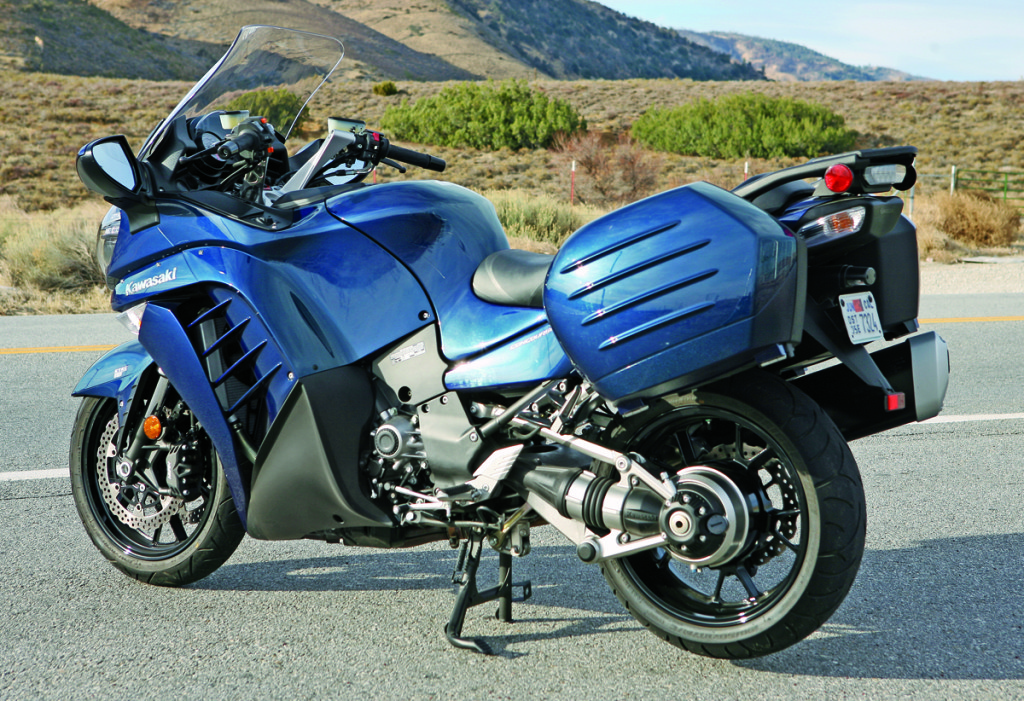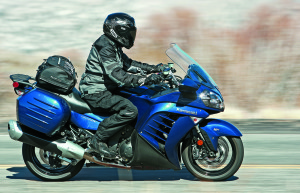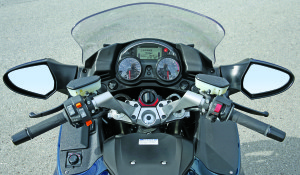
When the Kawasaki Concours 14 sped onto the sport-touring scene for 2008, it easily arm-wrestled the competition into submission. With its liquid-cooled, 1,352cc in-line four derived from the time-warping Ninja ZX-14 sportbike, the mighty Concours puts 144.2 horsepower to the rear wheel—4.4 more than the K 1600 GT even though the BMW has a 297cc displacement advantage (the BMW wins the torque war, with 115.8 lb-ft to the Kawi’s 95.3).
The complete reinvention of the Concours, after being in Kawasaki’s lineup mostly unchanged for more than two decades as the ZG1000, was about much more than just horsepower. Variable Valve Timing helps the engine run more smoothly and efficiently, the Tetra-Lever Swingarm eliminates shaft jacking and the KIPASS (Kawasaki Intelligent Proximity Activation Start System) key fob is an added security measure. By ticking all of the boxes that are important to us—performance, handling, comfort, value, reliability and practicality—the Concours 14 was a shoe-in for Rider’s 2008 Motorcycle of the Year.
We loved its large, 35-liter saddlebags and standard tire pressure monitor and heated grips, but were less enamored with its bulk, poor wind protection and felt engine heat. Updates for 2010 included a larger windshield, better heat management, improved handling, the introduction of KTRC traction control and an upgrade to K-ACT (Kawasaki Advanced Coactive-braking Technology) on ABS models (Rider, February 2010 and on ridermagazine.com).
At just $309 more than the Yamaha FJR1300, the $16,199 Kawasaki Concours 14 is one of the best deals in this test. But, like the BMW R 1200 RT, it’s showing signs of age. Adopting the engine and chassis improvements of the new 1,441cc Ninja ZX-14R would strengthen its position as el jefe of horsepower and improve handling. For the long haul, it could use adjustable ergonomics, cruise control, a trip computer, better wind protection and more fuel capacity.
 |
 |
2013 Kawasaki Concours 14 ABS
Base Price: $16,199
Warranty: 3 yrs., unltd. miles
Website: kawasaki.com
Engine
Type: Liquid-cooled, transverse in-line four
Displacement: 1,352cc
Bore x Stroke: 84.0 x 61.0mm
Compression Ratio: 10.7:1
Valve Train: DOHC, 4 valves per cyl. w/ Variable Valve Timing
Valve Adj. Interval: 24,000 miles
Fuel Delivery: Digital EFI w/ ram air & 40mm throttle bodies x 4
Lubrication System: Wet sump, 5.0-qt. cap.
Transmission: 6-speed, hydraulically actuated wet clutch
Final Drive: Shaft, 2.04:1
Electrical
Ignition: TCBI w/ digital advance
Charging Output: 581 watts @ 5,000 rpm
Battery: 12V 14AH
Chassis
Frame: Aluminum monocoque w/ engine as stressed member & cast aluminum Tetra-Lever swingarm
Wheelbase: 59.8 in.
Rake/Trail: 26.1 degrees/4.4 in.
Seat Height: 32.1 in.
Suspension, Front: 43mm male slider, adj. for spring preload &
rebound damping, 4.4-in. travel
Rear: Single shock, adj. for spring preload (remote) & rebound
damping, 5.4-in. travel
Brakes, Front: Dual floating petal discs w/ radial-mounted opposed 4-piston calipers & K-ACT linked ABS
Rear: Single petal disc w/ 2-piston pin-slide caliper & K-ACT linked ABS
Wheels, Front: Cast, 3.50 x 17 in.
Rear: Cast, 6.00 x 17 in.
Tires, Front: 120/70-ZR17
Rear: 190/50-ZR17
Wet Weight: 687 lbs.
Load Capacity: 485 lbs.
GVWR: 1,172 lbs.
Performance
Fuel Capacity: 5.8 gals., last 1.1 gal. warning light on
MPG: 90 PON min. (high/avg/low) 44.0/35.2/30.0
Estimated Range: 204 miles
Indicated RPM at 60 MPH: 2,750
This sidebar was published as part of our 2013 Sport-Touring Comparison Test: BMW K1600GT, BMW R1200RT, Kawasaki Concours 14, Triumph Trophy, Yamaha FJR1300.









Well took delivery 3 weeks ago and during run is through the Colorado mountains averaged 50MPG. 600 mile service and rode to Boise Idaho. 800+ miles. Teton pass + interstate and back on 50% interstate at 85mph and averaged 48MPG – don’t know where you got your figures from!
24K on the valve adjustment ? Book says 15K Please clairify.
From Vegas to Barstow I got 52.4 MPG going approx. 80 mph. 7,500 miles on it, so far no issues. Fun bike – crazy fast for a sport tourer. You’ll need bar risers unless you’re tall.
Service intervals
24000 kilometres
15000 miles